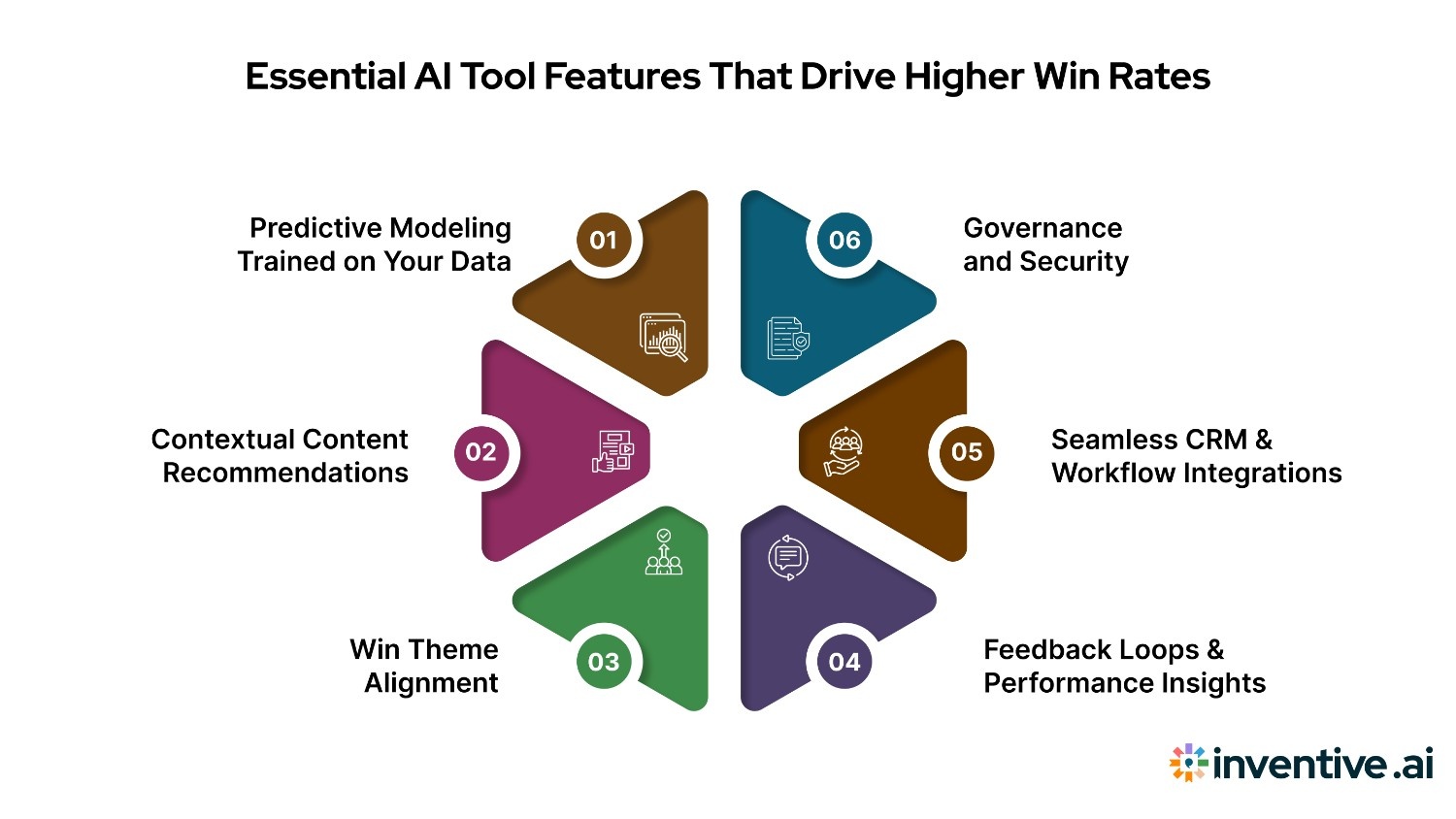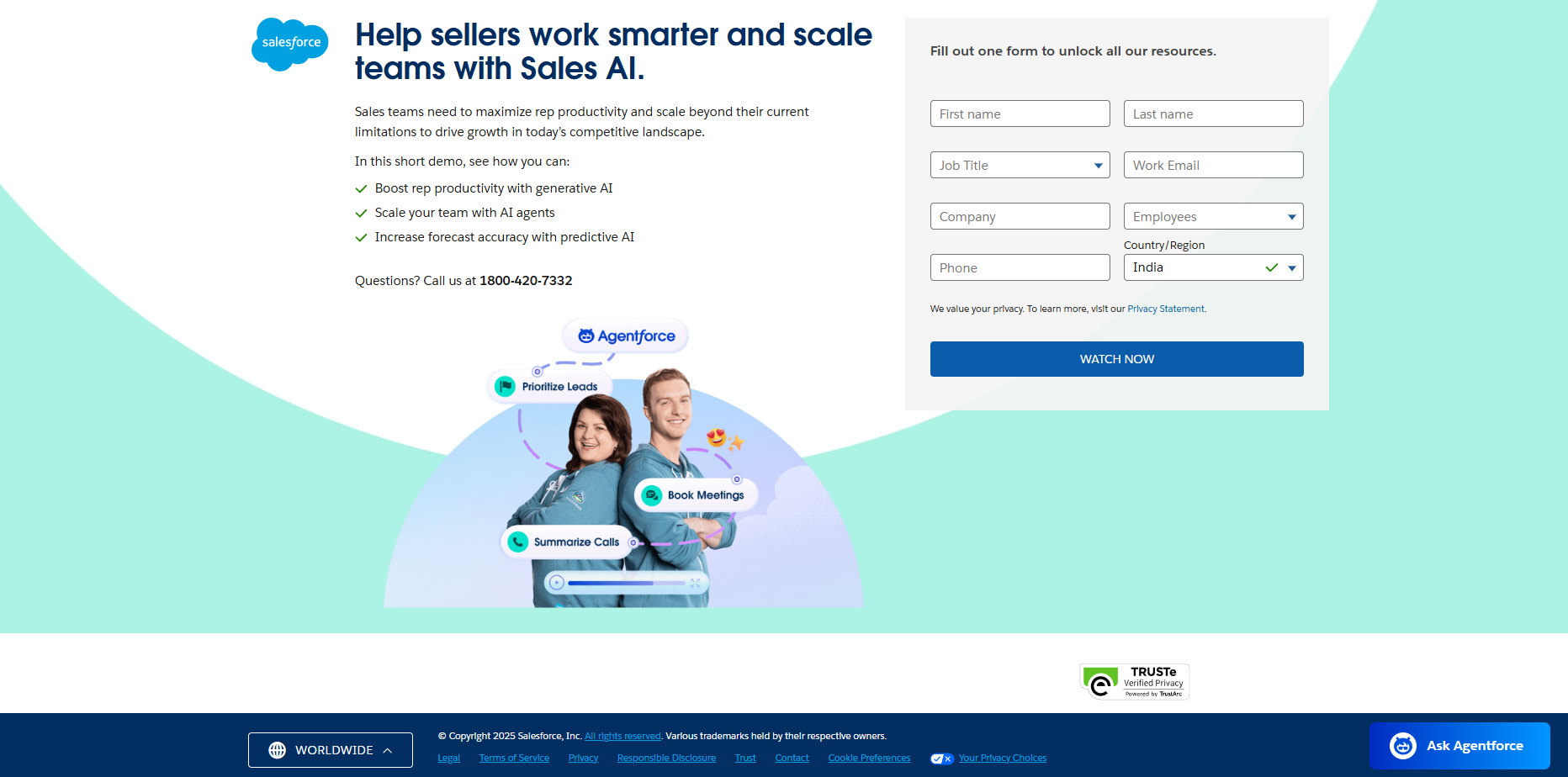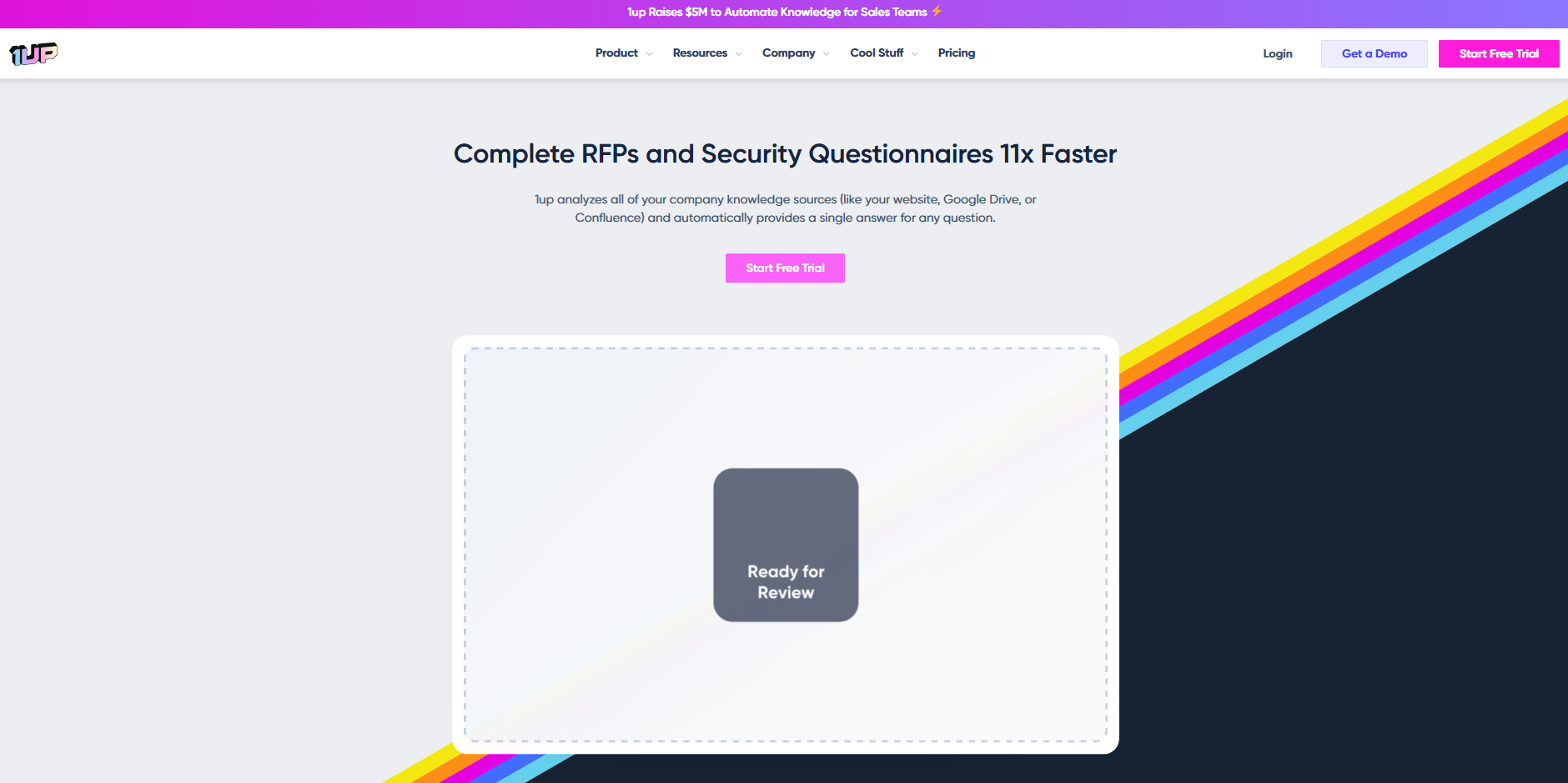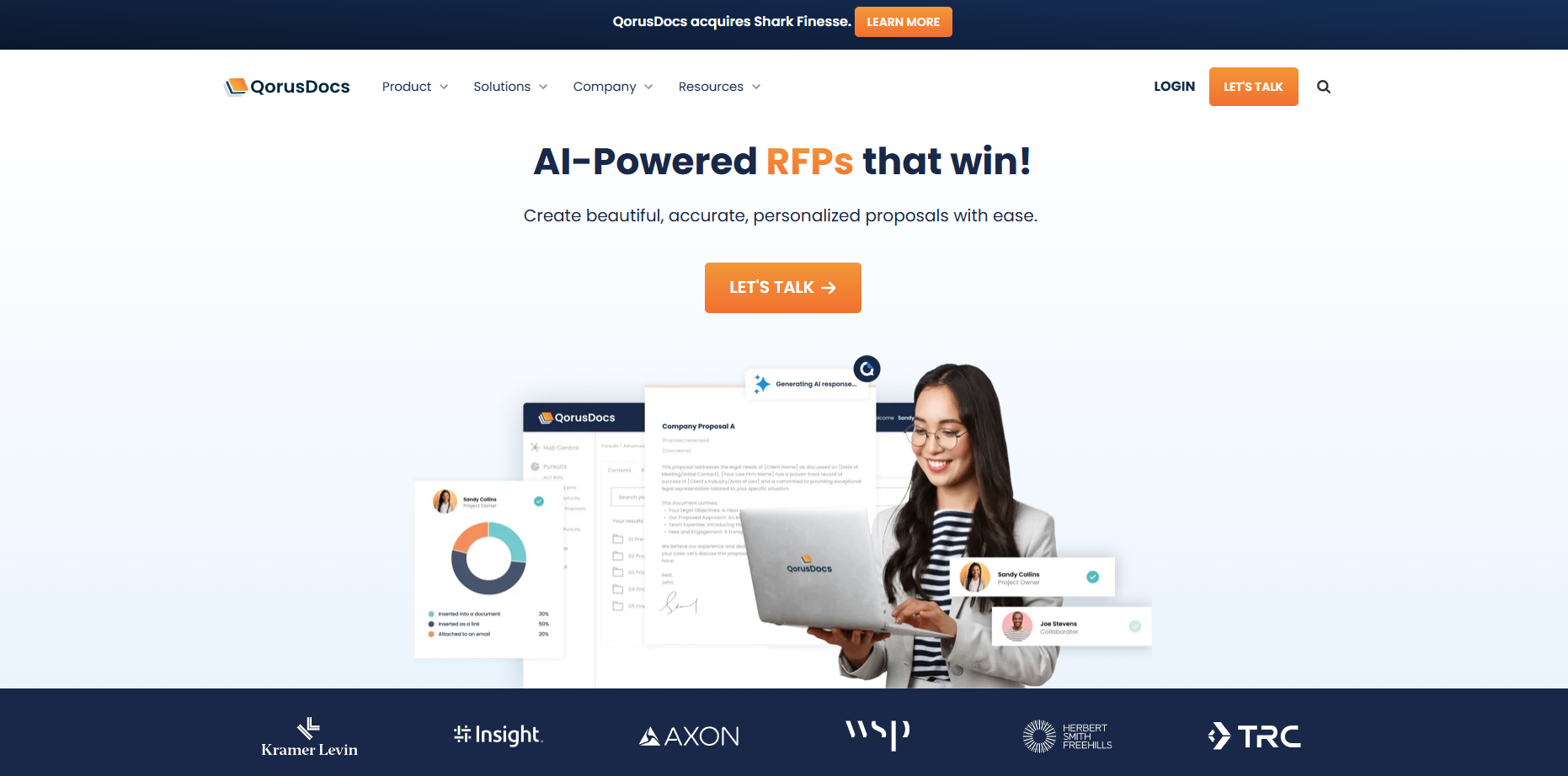Top 8 AI Tools to Boost Win Rates in 2025 (Sales & Proposals Edition)
In this blog, we’ll break down how AI tools directly influence win rates from predictive scoring models to conversation intelligence platforms and what sales teams can do to turn raw data into deal-closing insights.

Sales and proposal teams spend significant time chasing deals that should close but don’t. In many cases, the issue isn’t a lack of effort; it’s misaligned targeting, generic messaging, or slow responses that cost credibility with buyers. The result: win rates stall, even when pipelines look healthy.
Artificial intelligence is changing that equation. By analyzing buyer requirements, analyzing opportunity context, and recommending content that directly addresses specific pain points, AI tools help teams deliver solutions that feel personal, relevant, and timely.. Recent surveys show that organizations using AI in sales processes can see up to a 76% improvement in win rates when tools are applied effectively.
In this blog, we’ll break down how AI tools directly influence win rates from predictive scoring models to conversation intelligence platforms and what sales teams can do to turn raw data into deal-closing insights.
TL;DR: Key takeaways
- AI tools boost win rates by improving proposal speed, accuracy, and personalization.
- Success depends on data quality, integration, and adoption, not just tool choice.
- Inventive AI goes beyond drafting with Win Themes, zero hallucinations, and analytics.
- Teams using Inventive AI can respond up to 10× faster and improve win rates by 50%.
- The best results come from combining automation with human oversight and strategy.
Why Win Rates Matter And Where Traditional Methods Fail
Win rate is one of the most telling sales metrics, as it measures not only the volume of opportunities but also how efficiently a team converts them into revenue. Yet many organizations mismanage this metric by relying on outdated methods.
Common pitfalls in traditional approaches
- Gut-driven forecasting: Reps often rely on instinct rather than data, leading to overconfidence in weak deals.
- Static spreadsheets: Manually updated trackers quickly become outdated and don’t reflect real-time buyer signals.
- One-size-fits-all playbooks: Buyers expect tailored engagement, but manual processes often force generic outreach.
- Late risk detection: Teams discover deal blockers only at the negotiation stage, when it’s often too late to pivot.
The AI difference
In practice, AI boosts win rates by converting “exhaust data” (CRM activity, emails, calendars, and call transcripts) into deal scores, risk alerts, and next-best-action recommendations. This enables reps to focus on the right opportunities and intervene earlier. Teams using AI-driven forecasting, conversation intelligence, and proposal automation report higher revenue growth, faster cycle times, and fewer costly errors, all key drivers of conversion and sustained win-rate lift.
Also read: How to Improve Your RFP Win Rates
Key Features to Look for in AI Tools That Actually Move Win Rates

Not all AI solutions are designed to impact win rates directly. Some offer automation without improving deal quality or proposal strength. To see measurable results, organizations should evaluate tools against these capabilities:
- Predictive Modeling Trained on Your Data
Generic scoring models rarely align with your unique buyer profile. Effective tools use your historical win/loss data to refine predictions and improve opportunity prioritization. - Contextual Content Recommendations
Instead of generic templates, tools should suggest content blocks tailored to the opportunity, industry, or compliance requirements. This ensures responses resonate with evaluators. - Win Theme Alignment
Tools that can surface buyer priorities and map proposal responses back to them directly influence scoring outcomes. Without this, proposals risk being accurate but undifferentiated. - Feedback Loops & Performance Insights
Continuous improvement is key. Tools must track proposal success, buyer engagement, and response accuracy to refine recommendations over time. - Seamless CRM & Workflow Integrations
If AI insights live outside your sales or proposal systems, adoption drops. Native integrations with platforms like Salesforce, HubSpot, or SharePoint make the tools useful in daily workflows. - Governance and Security
Since proposals often contain sensitive financial, technical, or compliance data, tools must support permission controls, audit trails, and strong security standards.
By focusing on these features, enterprises can avoid “AI hype” and instead select tools that tangibly increase conversion rates.
Top 8 AI Tools That Can Help Boost Your Win Rates
AI solutions for sales and proposals fall into distinct categories. Each category addresses a different stage of the deal cycle, and when combined, they lift overall win rates.
1. Inventive AI

Gartner Rating: 5/5
Inventive AI is the industry’s most advanced AI-powered RFP and proposal automation platform, designed to help teams win more deals with precision, speed, and evaluator alignment. Purpose-built for presales, proposal, and enterprise sales teams, it combines deep natural language understanding with proprietary models fine-tuned for compliance-driven workflows.
Key Outcome-Based Capabilities
- Accelerates proposal turnaround by 10×:
Automatically generates context-aware, citation-backed first drafts that reflect your verified content. Teams move from blank pages to submission-ready responses in minutes instead of days. - Improves evaluator scoring alignment by up to 50%:
The proprietary Win Themes Engine identifies buyer priorities and maps every response to the exact evaluation criteria, ensuring proposals score higher on relevance and completeness. - Reduces rework and inconsistencies across teams:
The AI Conflict Manager detects stale, duplicate, or contradictory information before submission, preventing post-review corrections and saving hours of manual validation. - Boosts content reuse and proposal accuracy:
A unified Knowledge Hub connects content from Google Drive, SharePoint, Notion, and Confluence, creating a single, trusted source of truth that keeps every proposal factually aligned and brand-consistent. - Enhances collaboration across functions:
Real-time co-editing, role-based permissions, and Slack/Teams notifications ensure proposal managers, legal, finance, and SMEs stay synchronized without version chaos. - Provides measurable ROI through analytics:
Built-in dashboards track win rates, turnaround times, and content utilization, helping leaders quantify process improvements and identify high-performing response strategies.
Pros
- Precision drafting with grounded AI that eliminates hallucination risk.
- Seamless integrations with CRMs, content systems, and collaboration hubs.
- Scales easily from mid-market to large enterprise deployments.
Cons
- Offers essential analytics only; deeper insights require external tools.
Pricing
Usage-based pricing model, determined by the number of RFPs processed each month.
Best For
Enterprises and proposal-heavy organizations seeking faster, evaluator-aligned, and fully auditable RFP workflows that consistently improve win rates.
2. Clari

Gartner Rating: 4.7/5
Clari is a software platform that uses data from sales and engagement systems to generate forecasts and deal summaries. It consolidates information from CRM records, meetings, and emails into a single interface used for pipeline tracking and reporting.
Key Features
- Aggregates activity and CRM data for forecast visualization.
- Displays pipeline summaries and deal stage movement.
- Provides conversation logs and engagement timelines.
- Connects with Salesforce, HubSpot, and selected communication tools.
Pros
- Centralized deal and activity view within the same interface.
- Works with standard CRM systems.
Cons
- Forecast accuracy depends heavily on CRM data hygiene; poor data quality skews insights.
- Doesn’t automate proposal, quote, or evaluator-aligned workflows, limited late-stage impact.
- High setup cost and time-to-value for lean or mid-market teams.
Pricing
Custom pricing based on team size and data integration scope.
Best For
Organizations that use CRM-based forecasting and need a structured view of pipeline data.
3. Gong

Gartner Rating: 4.7/5
Gong records and processes sales calls, meetings, and emails to create conversation transcripts and activity logs. The platform is used for analyzing communication data and identifying recurring discussion topics within sales cycles.
Key Features
- Captures and transcribes meeting and call data.
- Tags mentions of products, pricing, and objections.
- Logs engagement frequency for accounts and contacts.
- Integrates with CRM and communication tools.
Pros
- Provides searchable records of sales communications.
- Operates within common CRM and conferencing systems.
Cons
- Generates vast conversation data but lacks clear workflows to act on those insights.
- Doesn’t integrate conversation intelligence into proposal or win-rate improvement workflows.
- High licensing costs per seat and limited customization for large presales teams.
Pricing
Custom pricing based on the number of users and recording volume.
Best For
Organizations that record and review sales communications for internal tracking.
4. Salesforce Einstein GPT

Gartner Rating: 4.3/5
Salesforce Einstein GPT is an AI component within Salesforce that automates basic CRM-related actions. It produces text outputs, summaries, and lead scores based on stored CRM information.
Key Features
- Generates summaries and notes from CRM records.
- Provides lead and opportunity scoring based on activity data.
- Suggests email content and short text responses.
- Functions entirely within the Salesforce environment.
Pros
- Embedded inside the Salesforce interface.
- Uses existing CRM data without external connections.
Cons
- Primarily focuses on CRM summaries and note-taking; lacks proposal or evaluator alignment.
- Limited adaptability outside the Salesforce ecosystem; heavy dependency on data completeness.
- Additional AI modules are expensive and require separate licensing.
Pricing
Included with select Salesforce editions; additional AI modules priced separately.
Best For
Teams already using Salesforce that require in-platform text and scoring automation.
5. Loopio

Gartner Rating: 4.4/5
Loopio is a cloud-based application used for organizing and reusing RFP content. It stores approved responses and assists teams in filling out questionnaires and proposals.
Key Features
- Centralized content library for RFP responses.
- Document import and export tools.
- Basic workflow routing for review and approval.
- Integrations with CRM and file storage systems.
Pros
- Provides a single repository for reusable answers.
- Supports basic collaborative editing.
Cons
- Manual content maintenance leads to outdated or inconsistent RFP libraries over time.
- Add-on AI features feel retrofitted rather than native, with limited contextual accuracy.
- No auto-detection for duplicate or stale content; relies on manual audits.
Suggested Alternative: Inventive AI
If you’re already using Loopio but want to evolve beyond static content reuse, Inventive AI delivers active evaluator alignment, grounded drafting, and conflict detection, improving both accuracy and win outcomes.
Pricing
Tiered pricing based on user count and feature access.
Best For
Teams that maintain recurring RFP content and require a shared library.
Suggested Alternative: If your team needs more than just pipeline tracking and forecasts, Inventive.AI offers a comprehensive, AI-powered solution for proposal creation, Rfp responses, proposal alignment, and evaluator-driven automation, ensuring proposals are not only managed but also optimized for win rates.
6. AutoRFP AI
.png)
Gartner Rating: 4.9 (based on ~12 reviews)
AutoRFP AI is a platform that uses AI models to create automated RFP responses and document drafts. It processes questionnaires, generates preliminary answers, and supports export in various file formats.
Key Features
- Automated draft generation from stored data.
- Simple workflow for assigning reviewers and approvers.
- Support for Word, Excel, and PDF exports.
- Integrations with cloud storage systems.
Pros
- Generates structured RFP responses automatically.
- Includes standard collaboration and version tracking tools.
Cons
- Interface and navigation are dated, making collaboration cumbersome.
- AI models provide generic responses with minimal contextual grounding.
- Lacks integrations with advanced CRM, collaboration, or security tools (e.g., Teams, Slack).
Pricing
Custom pricing, generally structured around project volume.
Best For
Teams requiring automated draft creation for standard RFPs or questionnaires.
Suggested Alternative: Inventive AI
Teams that use AutoRFP for insights but need action can complement it with Inventive AI, which turns buyer signals into faster, evaluator-aligned proposal drafts for measurable win-rate lift.
7. 1up

Gartner Rating: 4.9 (based on ~7 reviews)
1up is a software platform used for centralizing company information and retrieving standardized answers from multiple sources. It connects internal repositories to assist users in generating quick responses to sales or security questionnaires.
Key Features
- Connects data from Drive, Confluence, and other internal systems.
- Generates automated responses for RFPs and questionnaires.
- Offers a browser plugin for portal-based data entry.
- Allows simple collaboration across departments.
Pros
- Provides searchable access to internal documentation.
- Supports quick export of pre-approved content.
Cons
- Primarily functions as a knowledge retriever, lacks true proposal-generation capabilities.
- Struggles with complex question mapping in large RFPs.
- Requires frequent manual updates to keep data repositories current and accurate.
Pricing
Subscription-based, with custom tiers by user count.
Best For
Teams that maintain internal Q&A repositories for fast access to approved information.
Better Alternative:
While 1up accelerates content lookup, Inventive AI goes several steps further, transforming static answers into contextual, evaluator-ready proposals. With grounded AI drafting, automated content governance, and integrated collaboration, Inventive delivers twice the response quality and measurable improvements in win rates and turnaround time.
Inventive AI vs. 1up: Beyond Knowledge Retrieval
8. QorusDocs

Gartner Rating: n/a
QorusDocs is a document automation platform that operates within Microsoft Office applications. It is used for assembling and managing proposals, presentations, and other sales materials directly in familiar productivity environments.
Key Features
- Works within Word, PowerPoint, Excel, and Outlook.
- Stores templates for consistent formatting and branding.
- Connects with CRM platforms for inserting account data.
- Enables simple content searches inside Microsoft 365.
Pros
- Uses existing Microsoft tools without new interfaces.
- Supports template-based document creation.
Cons
- Restricted to the Microsoft 365 ecosystem, limited usability for hybrid tech stacks.
- No AI grounding or evaluator-alignment engine; primarily template-based automation.
- Steep learning curve for setup and customization within enterprise environments.
Pricing
Custom pricing determined by organization size and integration requirements.
Best For
Organizations using Microsoft Office that need standardized proposal and document formatting.
Better Alternative — Inventive AI
While QorusDocs standardises proposal layouts, Inventive AI transforms how teams create them. It combines grounded AI generation, buyer-aligned Win Themes, and cross-platform compatibility to produce proposals that don’t just look consistent; they win more often.
Inventive delivers 2× higher response quality, zero hallucination, and 90% faster turnaround, helping sales and proposal teams move beyond templates to intelligent, evaluator-ready submissions.
Also read: RFP Automation Checklist for Sales Success
Implementation Strategies and Pitfalls to Avoid
Adopting AI tools to improve win rates isn’t just about purchasing software. Success depends on how well the tools are integrated into existing processes and how teams adapt to using them.
Strategies for Effective Implementation
- Start With Clear Objectives
Define what “improving win rates” means for your team. Is it closing more RFPs, reducing stalled deals, or increasing sales conversion from 20% to 30%? Align tool selection with those outcomes. - Audit and Clean Existing Data
AI models are only as strong as the data they learn from. Before rollout, ensure your CRM, proposal libraries, and knowledge bases are accurate, current, and well-structured. - Pilot With High-Impact Teams
Begin with proposal managers or sales teams working on critical deals. A focused pilot builds proof of value and uncovers process gaps before a wider rollout. - Integrate With Daily Workflows
Adoption fails when tools sit outside normal routines. Choose AI platforms that connect directly to CRMs, collaboration hubs, and document systems your teams already use. - Establish Feedback Loops
Regularly measure key metrics like draft cycle time, proposal accuracy, deal velocity, and win/loss ratios. Use these insights to refine both the AI setup and team processes.
Common Pitfalls to Watch Out For
- Overreliance on AI Outputs
AI should accelerate work, not replace human oversight. Proposals still need SME input and strategic tailoring. - Ignoring Change Management
Sales and proposal teams may resist new workflows. Training, clear ownership, and leadership buy-in are critical for adoption. - Neglecting Compliance and Security
Many proposals involve sensitive data. Ensure tools offer role-based access, audit trails, and meet regulatory standards. - Chasing Too Many Tools at Once
Spreading resources across multiple overlapping solutions dilutes impact. Focus on 1–2 tools with the clearest link to win rates, then expand.
When implementation is disciplined, AI doesn’t just make teams faster, it makes their work consistently higher quality, which is the true driver of win-rate improvement.
Related: Best Practices for RFP Content Library Automation
Conclusion
Improving win rates is no longer about working harder; it’s about working smarter with the right tools. AI empowers sales and proposal teams to respond faster, tailor messages to buyer priorities, and maintain accuracy even under pressure. But the real differentiator is how purpose-built platforms like Inventive AI combine drafting speed, evaluator alignment, compliance safeguards, and analytics to deliver measurable improvements in both efficiency and outcomes.
Organizations that integrate these tools with a clear strategy and strong adoption practices can move beyond incremental gains. They can build a repeatable and scalable system that consistently wins more deals, even in highly competitive markets.
What customers say
“Saved our presales team a ton of time. Response quality is high, and the AI assistant is useful for ad hoc responses.”
— Verified G2 Reviewer, Solutions Engineering Team
“It helps me save time by automating tasks in RFP creation and content management. Speeds up document preparation and makes it easier to find information.”
— Verified G2 Reviewer, Logistics & Supply Chain
Frequently Asked Questions (FAQs)
1. How do AI tools improve sales win rates?
AI tools improve win rates by analyzing buyer behavior, predicting deal outcomes, and automating time-consuming tasks like drafting proposals. This allows sales teams to focus on the best opportunities and submit more competitive responses in less time.
2. Which AI tools are most effective for proposal teams?
Proposal teams often use tools like Inventive AI, Loopio, or Responsive, but Inventive AI is distinct because it is built specifically to align responses with evaluator criteria while ensuring accuracy and compliance. This makes it more effective in directly influencing win rates.
3. Is it safe to use AI tools for handling proposal data?
Yes, provided the platform meets enterprise security standards. Inventive AI ensures role-based access, SOC 2 compliance, and zero external data exposure, making it safe for sensitive RFP and proposal workflows.
4. Can AI replace sales reps or proposal managers?
AI does not replace people but complements them by handling repetitive work like drafting, formatting, and compliance checks. Sales reps and proposal managers still bring strategy, storytelling, and client relationships that AI cannot replicate.
5. How quickly can a team see results after adopting AI?
Teams typically see faster drafting cycles within weeks. Significant improvements in win rates generally become visible within three to six months of consistent use and process alignment.
6. What is the biggest mistake to avoid when adopting AI for win rates?
The biggest mistake is relying too heavily on AI without human review. While automation accelerates processes, proposals still need strategic tailoring and SME oversight to resonate with buyers.


